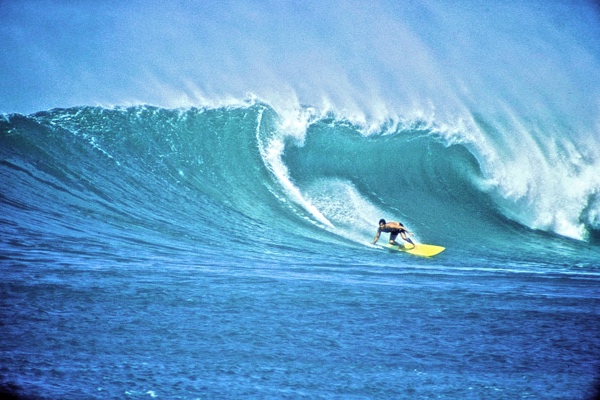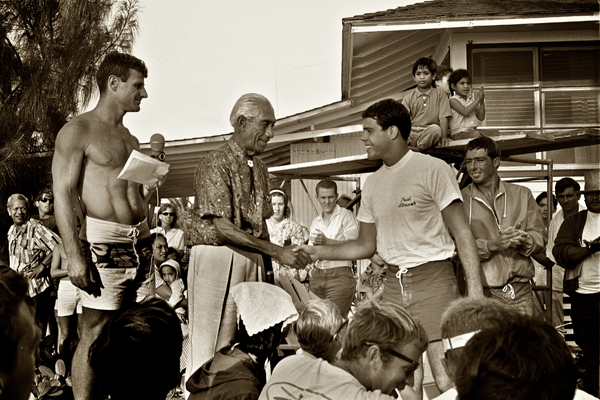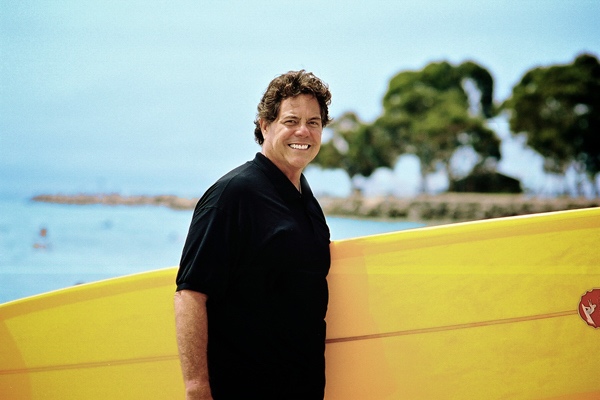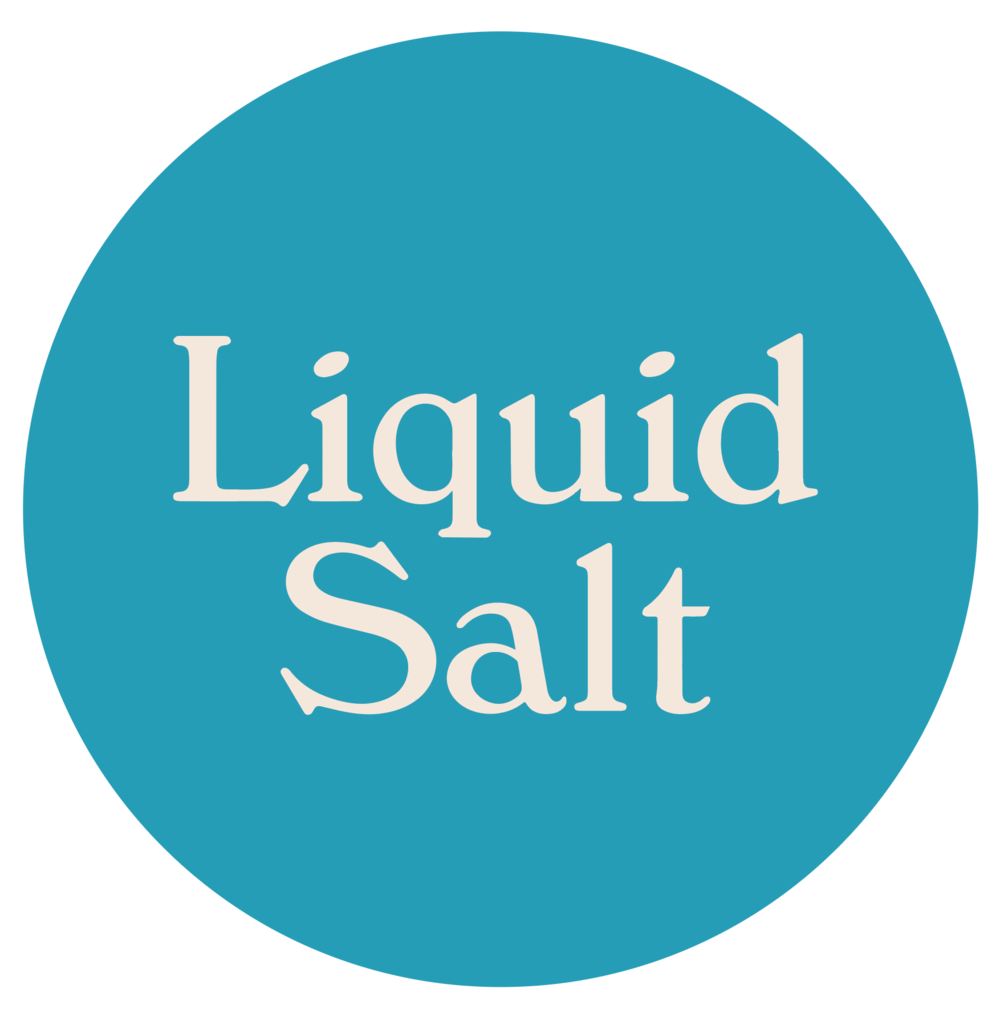Paul Strauch
Interview by Glenn Sakamoto





Paul Strauch is a Hawaiian-born surfer who is best known for his Cheater Five and smooth, graceful style both in and out of the water. Now based in California, Paul shares with us his philosophy and how important it is to surf through life with aloha, no matter the conditions.
What was it like growing up in the Islands?
I was blessed to be born into a part Hawaiian family. My mother was 3/4 Hawaiian and 1/4 English and my Dad, 1/4 Hawaiian and 3/4 German. So I learned the customary, traditional Hawaiian practices in terms of ethics and a natural appreciation for the ocean, land, and people. I was lucky and fortunate that my father had a strong affinity and relationship with the ocean – both surfing and fishing when he was young. He was extremely patient and an inspiring teacher to me.
When did you start surfing?
I started surfing at the age of 4 on my Dad’s redwood board. It was more like standing up on a large boat because at that early age it was almost impossible to move and turn on my own. He took me to the ocean because I was born with an underdeveloped chest and he felt surfing would increase my appetite and aid my muscular development. I remember being pushed into waves and learning the hard way… You know, swallowing water constantly, pearl-diving and hoping to keep the bruises and lumps down to a minimum.
What was the feeling you had when you got up on your feet?
It’s a feeling that is impossible to accurately describe. It was a total sensory experience while being propelled across the surface of the warm, crystal clear ocean where the water was like a giant aquarium – you could see the reef and the fish darting by, and the seaweed… It was very special and magical. A feeling I have lived and dreamed over and over and over again.
Who did you look up to and admire when you were a young man?
I was taught to surf right on Waikiki Beach. And there was a hierarchy. You learn who is at the top, and to work yourself into this system, you must have respect for those who have seniority. My dad was very close to the Waikiki Beach boys like Blue Makua among many others, and I got to know them personally. They kind of fathered me in the ocean when my Dad wasn’t around and were very helpful. Another beachboy who I admired as a mentor was Ed “Blackout” Whailey (older brother of Momi, Buffalo Keaulana’s wife) who was a classic surfer who stood very erect with a very smooth style. Of course, George Downing, an amazing surfer, shaper, waterman, close mentor and personal friend since I was 10 years old. Rabbit Kekai and his brother, Jamma, were also great surfers who I admired as well growing up.
Tell us about your first surfboard
My first balsa board was made in 1954 by Tom Blake and he made it at our house. He was a very quiet man. I got to know him slowly by sitting in the shadows and watching him work. I asked a lot of questions and he gave me his insight on all the facets of surfboard design like outline shape, bow or nose lift and what worked well and why. On my board, the balsa came hewn and we picked out the lighter pieces which measured just under 9 ft. by 4” by 6”. Tom cut about 3 ft. of one end of each plank on the diagonal and then glued the cut piece directly on top of that section on each of the four or five balsa planks, and then glued them all together. That’s how he would get a natural nose curve or bowlift.
When he shaped my board he also put a “swallow tail” on it. I had never seen this tail shape so I asked him why he did this and he told me, “You’re small and light so in order to increase maneuverability I put two points on the tail which would make it easier for you to turn. He did everything himself, from picking out the balsa wood from the local supplier, glued the pieces together, shaped the board, fiber-glassed the board and even made my fin from a mold – all in our back yard garage. It was my first real lesson in surfboard design and fabrication and I learned so much from observing and asking questions. It was a priceless learning experience.
How did you come up with the famous Strauch Crouch (Cheater Five)?
It was the direct result of trimming a heavy balsa board on a big wave. It was natural for me to crouch down and move forward toward the nose in order to go faster, hold in the wave and keep a tighter trim. And It just worked … logically. This “Strauch Cheater Five” maneuver became very popular through the surf magazines in the 60’s especially with California surfers on smaller waves which came as a total surprise to me to see so many surfers running up to the nose, crouching down and stretching their front foot to the nose.
You’ve influenced a number of talented surfers (Skip Frye, Gerry Lopez) who consider you their idol. How do you feel about that?
Not only are they heroes and extremely talented surfers – but they are people that I also look up to as well. I’m very flattered that they separated me in terms of style from others. BTW, their individual surfing styles are nothing short of pure grace and control in motion, and so inspiring to watch.
When I was growing up, especially in Waikiki, smoothness and style were extremely important and demonstrated experience and control. Once you were able to master changing directions on a wave, increasing speed and trimming, it became very important how you rode the board In terms of looking smooth and confident, surfing relaxed and as natural as possible. All the experienced surfers at that time surfed this way, and I learned from them that “style” was a key element to focus on and develop. It also got you respect and a lot more waves, too.
Who were some of your idols?
Besides the surfers I already mentioned and many others who I admired and haven’t mentioned, there were two others who in the late 50’s who were very significant to me… Dewey Weber and Phil Edwards. I didn’t know who they were when they first came to Hawaii in 1958 as there were no surfing magazines back then. I got to see them surfing at Makaha during the winter. They were very good although they both surfed different from each other in terms of their body movements and style. But they both used their upper torso, shoulders and arms to turn and change directions on the wave so effortlessly. I remember watching them and going out to mimic their turns and movements. At that time, there was only one other person who could surf with the same ability and style, and it was a Hawaiian surfer named Conrad Canha. Wow, he could really turn and flip his board around like a feather… An extremely gifted surfer of the time and definitely one of my idols.
What period of surfing holds the most cherished memories of surfing for you?
I would say my transition from riding small waves to big waves in the late ‘50s. Basically, I tried to surf big waves the same way I surfed small waves. The power of big surf forced me to analyze everything on a different level and really fascinated me. Your judgement had to be quicker, there was so much more water you were dealing with and the increased speed made the consequences much more severe. It was more exciting, thrilling and just more complex. Your equipment became more important– surfboard design was more critical, your judgment and timing were so important; you had to be alert all the time. Trying small wave maneuvering or “hot-dogging” as they called it then, was what I found so much easier to do on bigger waves. Ironically, I see today’s surfers approaching big waves with the same mindset.
What code do you live by?
I believe it all comes back to you. My parents taught me to always have respect for other people. I think it is the Hawaiian temperament I was raised with and have been able to carry on in my life. I learned it’s just so much easier to look at life with a smile, and be happy than it is to be unhappy. I guess I’ve been very fortunate with this background and lucky to have things open up for me, naturally.
Who/what inspires you?
There are a lot of people who inspire me and for many different reasons. I remember people who are so enthusiastic and energetic that it’s infectious, yet who are also sensitive, to others and everything around them. And when I have had the opportunity to get to know them personally, I found that they seem to radiate their energy and sensitivity in all walks of their life, and seem very content and happy. I like positive people and have always been drawn to them. People who have their life in order, are in control and enjoying every aspect of it.
What is the greatest thing you have learned in your life?
It would have to be contributing to someone else’s happiness. Because if you do that, it lasts forever. And no one can take that happiness away from you.
Do you have any regrets or wish you had done something differently?
None.
What are you most proud of?
I guess I would have to say that I am from Hawaii, and to have had that experience of the culture, music and the people. I am thankful I was born and raised in that lifestyle, parents and family. I was blessed and wish everyone had a basic, natural willingness to strive to be happy.
Who do you feel are shaping the path for surfing today?
I love what I am seeing now especially the young, progressive-minded longboard surfers like Alex Knost, Tyler Warren, Kai Sallas, and others who are riding different long and shortboard shapes for different types of conditions and surfing. They are using boards from the past, like the Fish, Quads and Alaias as well as super-longboards in the 11’0” range as well. It helps to create a wider perspective to your surfing. These surfers are becoming more universal in their approach and more adaptable to different conditions, waves and I’m sure are more fulfilled, too.
I believe that talent isn’t just a gift from God, it has to be developed. Every good surfer needs to be in superior physical condition, have excellent timing, good judgment and great equipment, and spend a lot of time in the water. I feel most importantly though, the experience should bring you great personal fulfillment and satisfaction.
What is your favorite board in your quiver?
I’ve actually been going back to what I rode in the ‘50s. Right now I’m revisiting the Pig shape with some modern improvements like hard rails in the tail section for quicker release on turns, a narrow nose and width moved back from center. I’m amazed at how easy it rides, turns and nose rides. It works perfectly in the Southern California surf, too. I guess Dale Velzy really knew what he was doing back in 1957.
What is your all-time favorite surf spot?
That’s easy – it has got to be Sunset Beach – what a challenging lineup, performance wave with all the elements that truly tests your ocean knowledge and skill. Number two would have to be Makaha for its diversity between small and big waves because when it’s over 20 feet it’s an entirely different ball game.
What’s your favorite meal?
I love Hawaiian food especially the Laulau. It’s basically luau leaves from the Taro plant, wrapped in Ti leaves with fish (although Butterfish is best to me!) and sweet potato and steamed. With poi and Lomi-lomi Salmon, it is probably my all-time favorite dish.
What kind of music are you listening to these days?
I like all kinds of music. I love the old Hawaiian virtuosos both instrumentalists and voice like Gabby Pahinui, Jessie Kalima, Genoa Keawe, The Sons of Hawaii, but I also like a lot of jazz, blues and reggae, too.
What causes/organizations do you support?
The ocean has been such a large part of my life, that I am 100 percent in support of organizations that preserve the ocean’s health and maintain them for the future generations. Also, organizations that provide rights of access (to beaches) and those that believe in humanity as a whole – and that also includes animals.
What’s next for Paul Strauch?
I plan to maintain my relationship with the ocean and enjoy it as long as I can. And also to encourage and nurture others so that they can find the joy and tranquility that the ocean has brought to me and my life.
First photo by John Severson, second photo by Jeff Divine. Portrait by Eric Jordan. All other photos courtesy of Paul Strauch.
